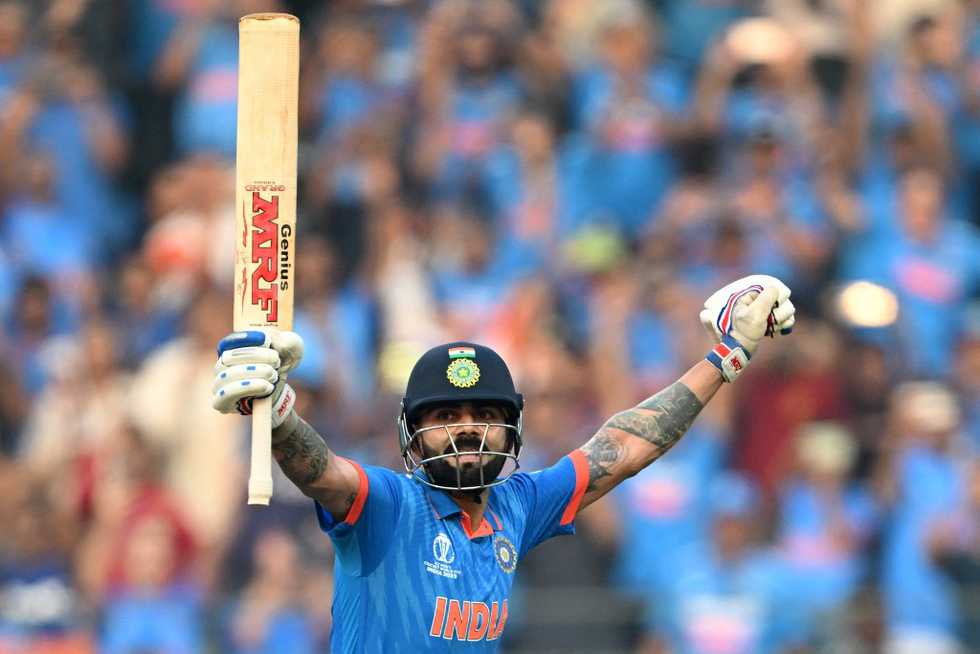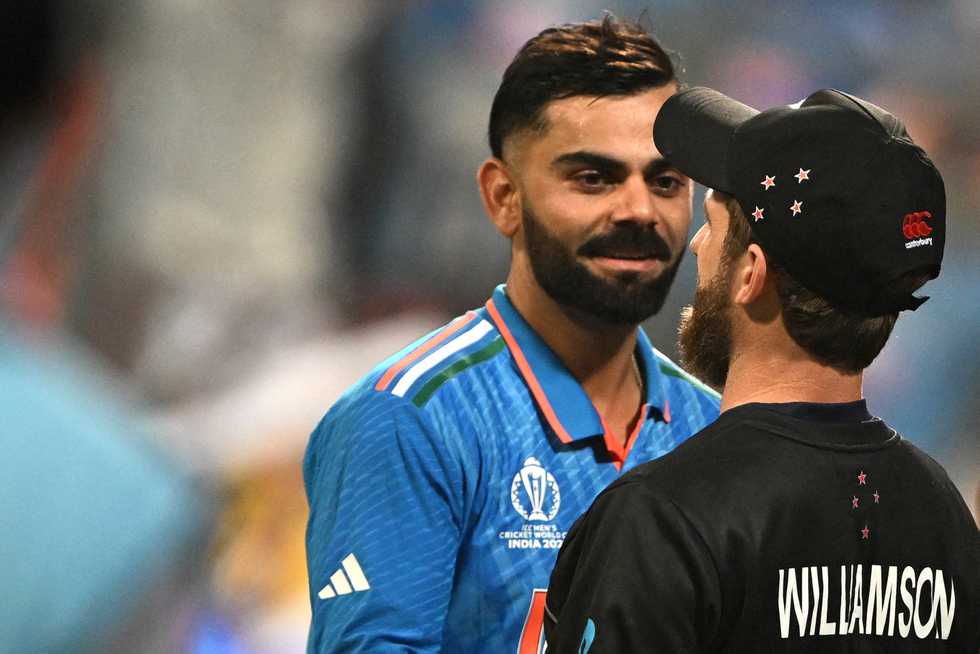

Seven minutes past five on Wednesday evening as the sun continued on its descent into the sea on the west, Mumbai's famous local trains honked and clattered away to the east of the Wankhede Stadium, carrying thousands home to an evening of dreaming. Inside the famous arena, one man was living something he hadn't even dreamt of.
The moment played out in the most Kohliest of ways: a whipped-flick for a two, with the ball placed between long leg and deep mid-wicket at a distance that neither of those two onrushing fielders would be able to reach quickly enough to deny the second run. Virat Kohli ran past the crease, the stumps and the wicket-keeper before taking flight, in a celebratory leap. Then gravity, of both the literal and the situation kind, as well as the sapping humidity brought him to his knees. The helmet was yanked off and from within it emerged a smile.
It was cricketing bedlam, a situation so wild that none of it quite made any sense until Kohli was standing once more and now bowing in reverence to the hero he'd just left behind, who was part of the applause din. Sachin Tendulkar was smiling. They were all smiling.
In a career of glittering achievements, this felt like a particularly seminal moment for the 35-year-old millennial, who was two months shy of his 10th birthday when the record for the most ODI centuries last changed hands, from Desmond Haynes to Tendulkar in the September of 1998 in Bulawayo. It was a very different time. ODI cricket was at its peak. Cricket Trump cards were in vogue. And if you ever held the Tendulkar card printed any time post 1998, you didn't have to call out 'hundreds'. Simply flipping the card in your hand with a smug expression was a socially accepted convention. Your opponents implicitly and grudgingly handed you the top card from their pile. No questions asked. It is likely that Kohli himself indulged in this tick. It is that record he now owns.
Kane Williamson, a great of the game, gave the 50th ODI century a more modern context when he said: "I think if you play 50 games, some people would call that a great career, to get 50 hundreds... geez..."
And if you thought he was being typically Williamson, extra generous with his compliments, then it is worth noting that the New Zealand team actually hands out mementos in the pre-match huddle when a player gets to his 50th ODI. Ish Sodhi was a recent recipient during the World Cup game against Pakistan in Bengaluru.
***
Kohli could have got to the mark there three days ago in Bengaluru, the city that has adopted him as one of its own. The M. Chinnaswamy Stadium had cut-out standees from each of his 49 centuries dotted around one side of the ground. When Kohli got to a half-century, anticipation was rife and perhaps a 50th cut-out was being readied on short notice. But against the run of play, he missed a ball from Roelof van der Merve and was bowled.
As spectacular as a venue Bengaluru is, such a milestone in a brushing aside of Netherlands may not have felt as perfect. For, Kohli has always unashamedly been a man of the bright lights and the big occasion. That has been his cricketing story in a nutshell.
Picture this setting instead. A World Cup semifinal against New Zealand, a team that has been the scourge of his title-winning dreams from the time he was captain. Add to that his own surprisingly poor record in ODI World Cup knockouts, an average of 12.16 from six games with a best of 35. But most of all, the fact that this game was in Mumbai, the spiritual home of Indian cricket, and was attended by the who's who of the city, including Tendulkar himself while Viv Richards commentated on his innings. Claiming the crown in this setting would cement the lineage of ODI batting greatness across the three generations.
And he played here like destiny called, knocking off other records along the way. Ricky Ponting was passed for the most ODI runs. Then Tendulkar was surpassed for most 50+ scores [8] in a World Cup campaign. Then fell another of Tendulkar's two-decade-old record for the most runs in a single World Cup campaign [673].
He didn't string together a series of big shots like Rohit Sharma or Shreyas Iyer did but instead used his heightened game awareness to pick moments when to take charge, like targeting a boundary option early in the over against key opposition bowlers. He stepped out and crunched Trent Boult over mid-off. Tim Southee was launched over cow corner with a disdainful flick of the wrist. Between all of this, he continued to play peak percentage cricket, dealing in a healthy diet of singles and twos and generally going at a strike-rate in the late 80s to early 90s for the most part.
It is true that Rohit setting up innings after innings like a runaway freight train has helped Kohli to continue at the tempo that serves him best and from where it becomes near impossible to get him out. But the reverse is also true, knowing that Kohli can expertly shut one end and bat through has allowed Rohit and Co. the freedom to bring that unprecedented ferocity even to a knockout contest despite missing out on the Hardik Pandya-offered batting depth - essential for such a high-risk strategy.

It's not easy to sustain such a high intensity and exhaustive style of play for 15 years, which is how long it has taken him to surpass this Tendulkar high-water mark. He isn't a batting genius like Tendulkar or a technician like Rahul Dravid. Even Rohit might claim to have a greater range of shots. But what Kohli is a little of all of this and a little more.
To score an average of 53 non-boundary runs per hundred comes with sacrifices as well as supreme physical conditioning and preparing for the extreme case scenarios. The night before the semifinal, when everyone seemed satisfied with their hits, he carried on for another 10 minutes playing no-footwork shots against throwdowns, exactly the sort he resorted to either side of the hundred when a cramp to his right hamstring restricted his mobility. Those strokes, brought him, and the team, at least 20 more runs.
"I think for me, it's not so much about the skill that he has, but it's more about the hunger when he goes there and the intensity with which he plays the game is what inspires me," Shubman Gill would say at the end of the game. "And to be able to have that consistently for as long as he's been doing it is what really inspires me."
Well past 10 PM, the Wankhede Stadium was awash in a celebratory mood and Kohli, now playing the crowd conductor, was still going strong. When Tim Southee miscued a pull in the 98th over, he got off the blocks from long-off faster than Gill did from long-on. As it turned out, Southee had horribly mistimed and the ball fell well short of both the fielders, but that didn't stop Kohli from teasingly suggesting that he was quicker than his younger teammate. Gill, of course, laughed it off, gesturing that he had a much wider starting position and therefore was a longer distance away from the ball.
A short while later, it was all over and Kohli had put India into another World Cup final. As the stadium emptied, the famous local trains carried thousands more into a night of dreaming.
| Share | Tweet |





